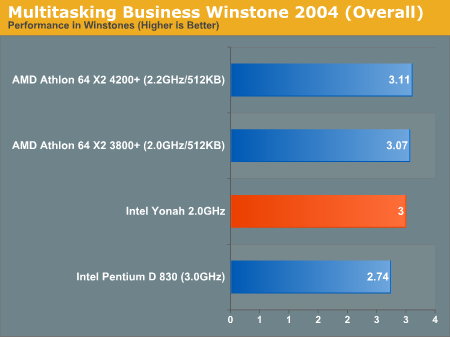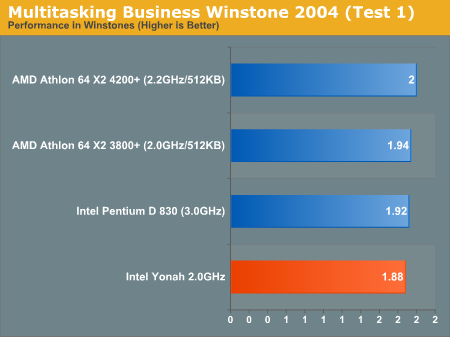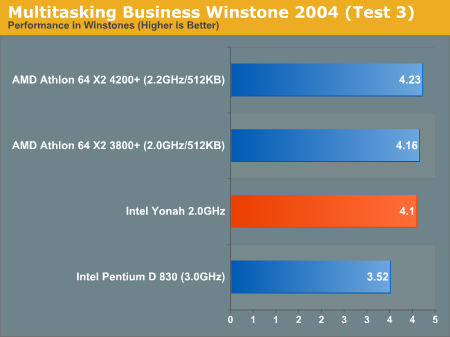Intel Yonah Performance Preview - Part I: The Exclusive First Look at Yonah
by Anand Lal Shimpi on November 30, 2005 2:50 AM EST- Posted in
- CPUs
Multitasking Performance
Business Winstone 2004 includes a multitasking test as a part of its suite, which does the following:
"This test uses the same applications as the Business Winstone test, but runs some of them in the background. The test has three segments: in the first, files copy in the background while the script runs Microsoft Outlook and Internet Explorer in the foreground. The script waits for both foreground and background tasks to complete before starting the second segment. In that segment, Excel and Word operations run in the foreground while WinZip archives in the background. The script waits for both foreground and background tasks to complete before starting the third segment. In that segment, Norton AntiVirus runs a virus check in the background while Microsoft Excel, Microsoft Project, Microsoft Access, Microsoft PowerPoint, Microsoft FrontPage, and WinZip operations run in the foreground."

When it comes to multitasking performance, the 2.0GHz Yonah remains quite competitive with the X2 3800+. We were curious as to whether or not the shared L2 cache would mean that single-to-dual core scaling would be improved at all, but to really answer that question we'll need a single core Yonah...













135 Comments
View All Comments
coldpower27 - Wednesday, November 30, 2005 - link
It doesn't seem that bad actually at 423US for 2.0GHZ Yonah at launch, it isn't double the 294US, that they are charging for Dothan 2.0GHZ parts now, the price isn't like the double we are seeing on Athlon 64x2.Furen - Wednesday, November 30, 2005 - link
Huh? I'm saying that the FX-60 will probably match the EE edition of Yonah, which (supposedly) will have a 50+ W TDP and will hardly be a "mid-range" mobile chip.coldpower27 - Wednesday, November 30, 2005 - link
These are the leaked pricing sheets from around the web on the launch pricing of Yonah.T2600/ Yonah 2.17GHZ/667/2MB 637US
T2500/ Yonah 2.00GHZ/667/2MB 423US
T2400/ Yonah 1.83GHZ/667/2MB 294US
T2300/ Yonah 1.67GHZ/667/2MB 241US
T means somewhere in 25W-49W TDP
Yonah Extreme Edition would be interesting, either 2.5GHZ/2.66GHZ if on the same FSB speed.
Furen - Wednesday, November 30, 2005 - link
It would have been nice if you'd included Dothan's power consumption just to see whether or not the "Yonah will have a 49W TDP" claims have any validity. I dont suppose you guys are up to testing the current CPU's current draw directly, huh? :)coldpower27 - Wednesday, November 30, 2005 - link
Also you got to keep in mind Yonah will fall in the T category, of processors which is 25W-49W in TDP, with the way Intel measures it. The acutal TDP of Yonah was supposed to be 31W.Furen - Wednesday, November 30, 2005 - link
Yes, but when Intel announced that Yonah was going to fall into that category EVERYONE (most tech sites, heck, even Cnet) equated that to a higher TDP Yonah, which is why it would have been nice to have something to compare it against.bob661 - Wednesday, November 30, 2005 - link
Anandtech is NOT measuring TDP in these tests!!!!!! They ARE measuring what they call "Total Power Consumption". These are two TOTALLY different measurements. AT can only measure power consumed by the ENTIRE computer coming from the wall socket. They can't measure TDP in these tests. It's not the same. It's not the same. Jesus!Furen - Sunday, December 11, 2005 - link
I never said they could measure TDP. I asked if they were willing to measure the CPU's current draw directly, which is VERY doable, though it takes a bit more effort. If you remember that a month or so ago there were news articles published at, basically, all tech news sites claiming that Yonah would have a greater TDP than it was originally anticipated. Though TDP is not necessarily the typical power draw, a higher TDP (compared to another one that is defined the same way) can lead to a higher current draw.I said that it'd be nice if they could include dothan in order to have a CPU with which to do an apples to apples comparison. Try to keep your patronizing comments to yourself if you don't plan on at least reading what you're commenting on properly.
Calin - Friday, December 2, 2005 - link
Nobody can measure the TDP - TDP is the Total Designed Power - and refer mostly to the cooling capacity of the processor package. You will see several models of processors having the same TDP even if their power consumption is certainly different.The Sempron 2500, 2600, 2700 and I think 2800 have the same TDP - even if the 2500 is a 256kB L2 cache part and the 2600 and 2800 have just 128kB L2 cache.
TDP is NOT power consumption!
Calin - Friday, December 2, 2005 - link
Sorry. TDP is thermal design power